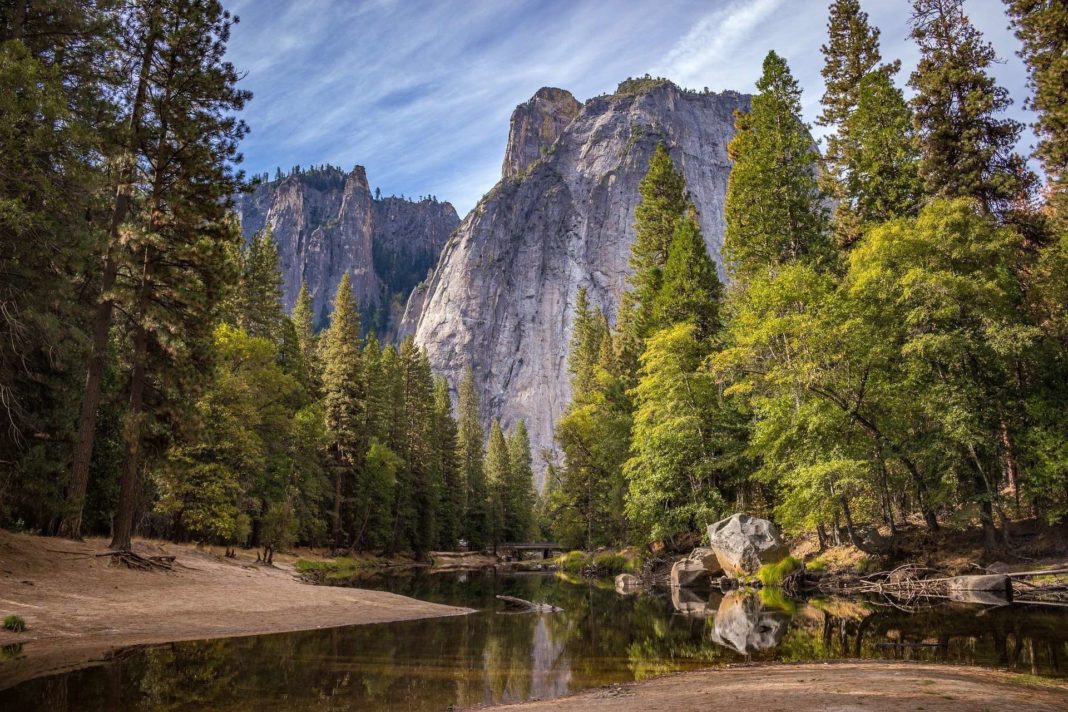To preserve a paradise on earth, stretching for tens of thousands of kilometers – this is Yosemite, one of the oldest reserves in the United States, established since the time of Abraham Lincoln. A destination visited by over 3 million tourists a year, it is an inspiration for artists, climbers and nature lovers. The extraordinary richness of flora and fauna, the unique formations made by Mother Nature, leave visitors breathless with admiration. It is no coincidence that the name Yosemite is cultivated by anyone who has touched its magic, whether by climbing, walking, camping, or just contemplating the natural beauty. And there is hardly a limited number of places to visit and things to do in Yosemite Park, but we have selected the following that you should not miss:
1. Yosemite Falls
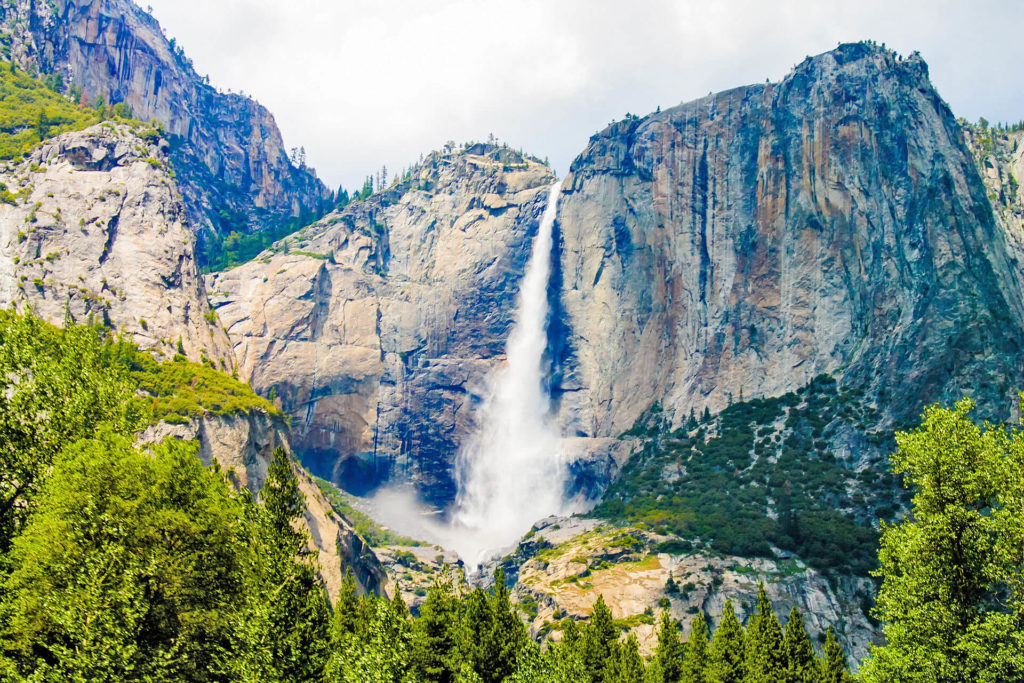
Yosemite Falls is a spectacular waterfall located in Yosemite National Park, in the Sierra Nevada mountains of California. With a total height of 2,425 feet (739 meters), it is one of the tallest waterfalls in North America.
The falls consist of three sections: the upper falls, the middle cascades, and the lower falls. The upper falls drop 1,430 feet (440 meters) in a single plunge, making it one of the twenty highest waterfalls in the world. The middle cascades are a series of smaller falls that drop a total of 675 feet (206 meters), while the lower falls drop 320 feet (98 meters) in a series of smaller steps.
Yosemite Falls is fed by snowmelt and usually flows from late fall through early summer, with peak flow typically occurring in May. In winter, the falls can freeze and create beautiful ice formations.
The falls can be viewed from several locations within Yosemite National Park, including Yosemite Valley, Yosemite Village, and various hiking trails. The most popular viewpoint is located near Yosemite Lodge, which offers a panoramic view of the falls. Several hiking trails lead to different viewpoints, including the 7.2-mile (11.6 km) round-trip hike to the top of the falls, which offers stunning views of the valley and surrounding mountains.
2. Half Dome
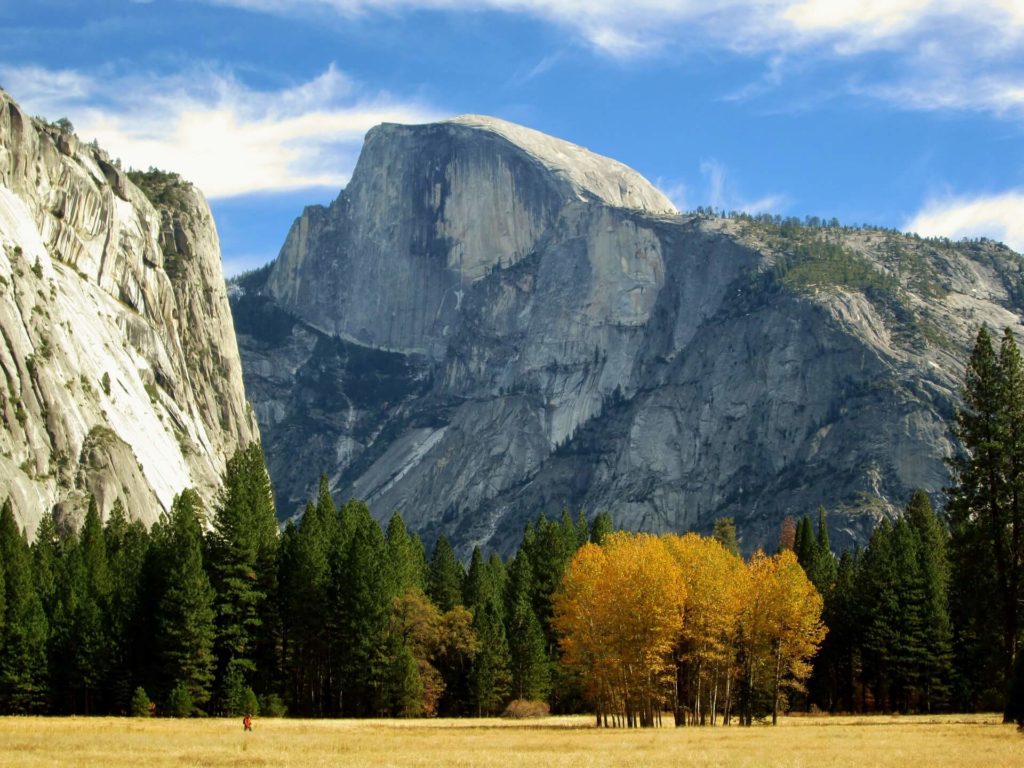
Half Dome is a granite dome located in Yosemite National Park in California. It rises about 4,737 feet (1,444 meters) above the valley floor and is one of the most recognizable features of the park.
The dome was formed by glacial and erosional processes over millions of years. It is made of granite, which is known for its durability and resistance to erosion. The dome has a unique shape, with a flat top and a steep face that drops nearly 2,000 feet (610 meters) on the east side.
Half Dome is a popular hiking destination and a symbol of Yosemite National Park. The most popular route to the top is the Half Dome Trail, which is about 14-16 miles (22-26 km) round-trip and involves a steep ascent up the face of the dome using a series of cables and metal posts for support. The hike is considered strenuous and requires a permit, which can be obtained through a lottery system.
The view from the top of Half Dome is breathtaking, with panoramic views of Yosemite Valley and the surrounding Sierra Nevada mountains. Hikers are advised to start early in the day, bring plenty of water and food, and wear sturdy hiking shoes. The climb up the cables can be intimidating for some, but the sense of accomplishment and the view from the top make it well worth the effort.
3. El Capitan
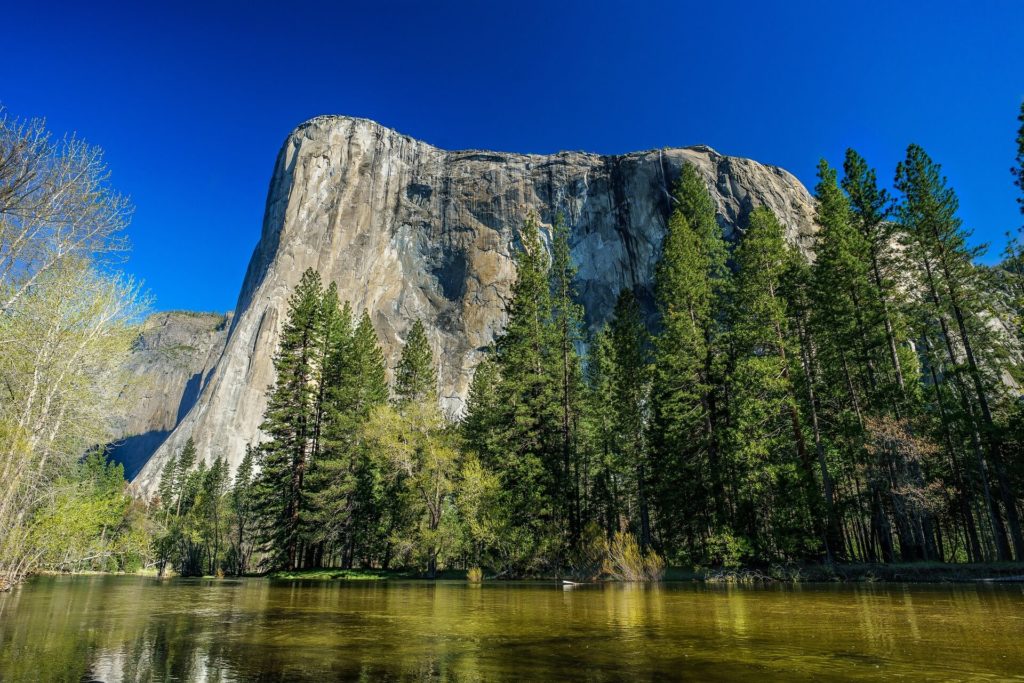
El Capitan is a granite monolith located in Yosemite National Park in California, USA. It rises approximately 3,000 feet (910 meters) above the Yosemite Valley floor and is one of the largest granite cliffs in the world.
El Capitan is a popular destination for rock climbers, who are drawn to its challenging routes and impressive scale. The first ascent of El Capitan’s sheer face was completed in 1958 by a team of climbers led by Warren Harding, using ropes and pitons over the course of 47 days. Today, climbers use a variety of techniques and equipment to ascend the cliff, with some routes taking as little as a few hours to complete.
In addition to its popularity among climbers, El Capitan is a major tourist attraction in Yosemite National Park. Visitors can view the monolith from several locations within the park, including El Capitan Meadow, which offers a clear view of the cliff face.
El Capitan is also known for its role in popular culture, having been featured in numerous films, television shows, and books. Notably, it was prominently featured in the 2018 documentary film “Free Solo,” which follows rock climber Alex Honnold as he becomes the first person to free solo climb El Capitan’s 3,000-foot (910-meter) sheer granite face without ropes or safety gear.
4. Tunnel View
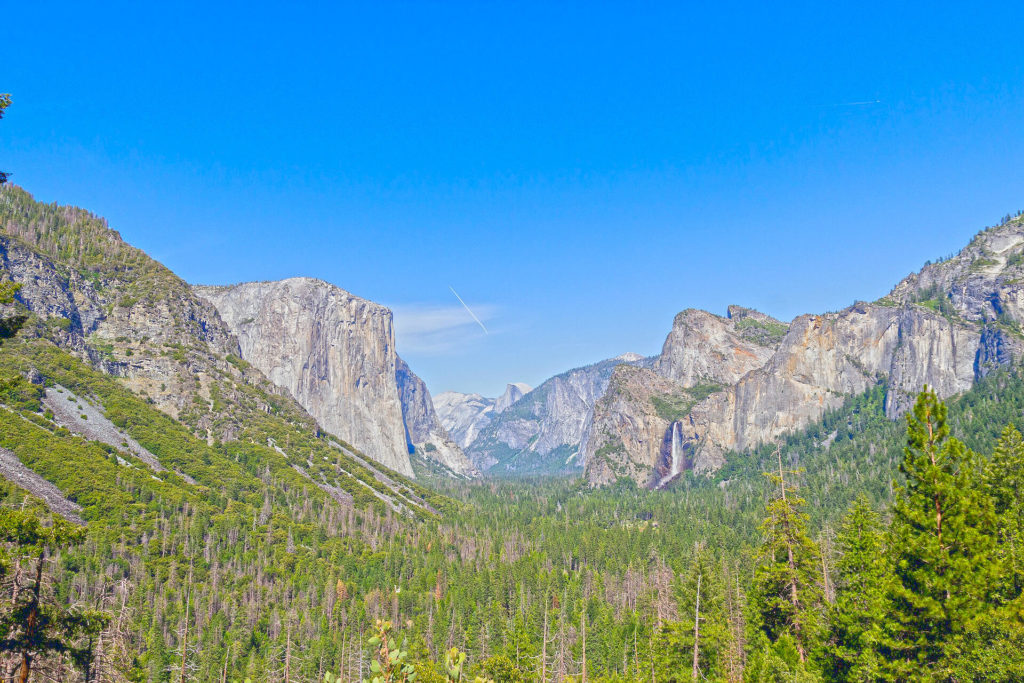
Tunnel View is a scenic overlook located in Yosemite National Park in California, USA. It is situated at the east end of the Wawona Tunnel, which cuts through the mountains and provides access to Yosemite Valley.
From Tunnel View, visitors are treated to a breathtaking panoramic view of Yosemite Valley, including El Capitan, Half Dome, and Bridalveil Fall. The view is often described as one of the most iconic and recognizable vistas in the world, and has been featured in countless photographs, paintings, and films.
Tunnel View can be accessed by car or shuttle bus, and is a popular stop for visitors to the park. There is a large parking lot at the overlook, as well as restrooms and interpretive exhibits that provide information about the geology and history of the area.
Tunnel View is especially popular at sunrise and sunset, when the light can create dramatic shadows and illuminate the valley in shades of pink, orange, and gold. It is also a popular spot for photographers, who come to capture the stunning scenery and changing light.
5. Climbing
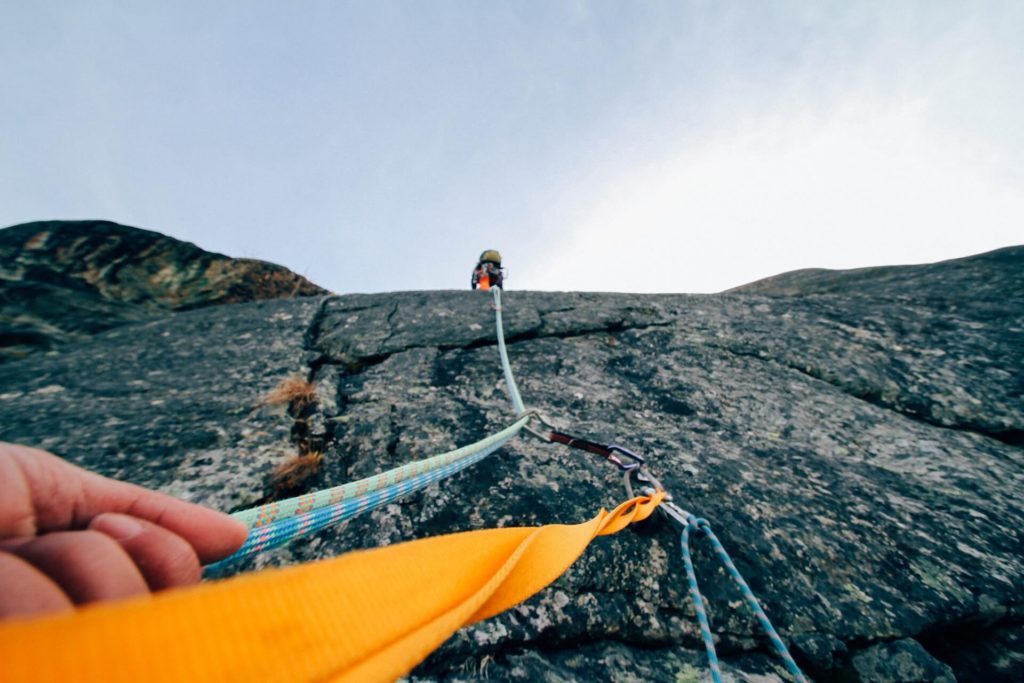 Yosemite National Park is a world-renowned destination for climbing, with some of the most iconic and challenging climbing routes in the world. The park offers a variety of climbing opportunities, including traditional rock climbing, big wall climbing, and bouldering.
Yosemite National Park is a world-renowned destination for climbing, with some of the most iconic and challenging climbing routes in the world. The park offers a variety of climbing opportunities, including traditional rock climbing, big wall climbing, and bouldering.
Traditional rock climbing in Yosemite involves climbing natural rock formations with the use of gear such as ropes, harnesses, and anchors. Some of the most famous rock climbing destinations in Yosemite include El Capitan, Half Dome, and Cathedral Peak. These formations offer challenging routes that require a high level of skill and experience, as well as an ability to manage long, multi-day climbs.
Big wall climbing is a sub-discipline of traditional rock climbing that involves ascending large, sheer rock faces such as El Capitan. Climbers must carry all of their gear with them and sleep on the face of the rock using specialized portaledge systems. Big wall climbs can take several days or even weeks to complete, and require a high level of physical and mental endurance.
Bouldering is a form of climbing that involves scaling large, low-level rock formations without the use of ropes or harnesses. Yosemite Valley and Tuolumne Meadows are popular bouldering destinations in the park, with numerous routes that range in difficulty from beginner to advanced.
Climbing in Yosemite requires a permit, which can be obtained through the park’s Wilderness Permit Office. Climbers are also encouraged to practice Leave No Trace principles, respect park rules and regulations, and take steps to ensure their own safety and the safety of others.
6. Hiking
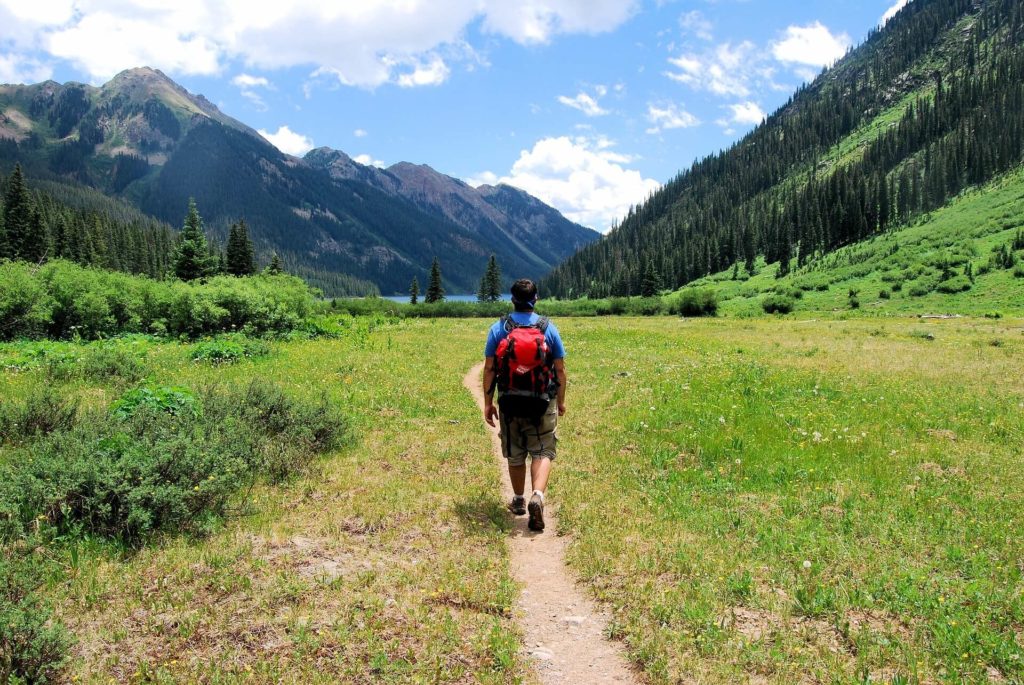 Yosemite National Park offers some of the best hiking opportunities in the world, with over 750 miles (1,200 km) of trails that lead to stunning vistas, waterfalls, lakes, and other natural wonders. There are trails suitable for hikers of all skill levels, from easy nature walks to challenging backcountry hikes.
Yosemite National Park offers some of the best hiking opportunities in the world, with over 750 miles (1,200 km) of trails that lead to stunning vistas, waterfalls, lakes, and other natural wonders. There are trails suitable for hikers of all skill levels, from easy nature walks to challenging backcountry hikes.
Some popular hiking destinations in Yosemite include:
- Yosemite Valley: The valley is home to some of the park’s most iconic landmarks, including Yosemite Falls, Half Dome, and El Capitan. There are numerous hiking trails in the valley, ranging from easy strolls to more challenging hikes.
- Glacier Point: Located on a high point overlooking Yosemite Valley, Glacier Point offers stunning views of Half Dome, Yosemite Falls, and other landmarks. Hiking trails lead to Glacier Point from the valley floor and from nearby trailheads.
- Tuolumne Meadows: Located in the park’s high country, Tuolumne Meadows is a beautiful alpine meadow surrounded by granite peaks. There are numerous hiking trails in the area, ranging from easy strolls to challenging backcountry hikes.
- Mariposa Grove: The Mariposa Grove is home to over 500 giant sequoia trees, some of the largest and oldest trees in the world. There are several hiking trails in the grove that allow visitors to explore these magnificent trees up close.
Hikers in Yosemite are encouraged to follow Leave No Trace principles, respect park rules and regulations, and take steps to ensure their own safety and the safety of others. Hikers should also be prepared for changing weather conditions, bring plenty of water and food, wear appropriate clothing and footwear, and carry a map and compass or GPS device.
7. Glacier Point
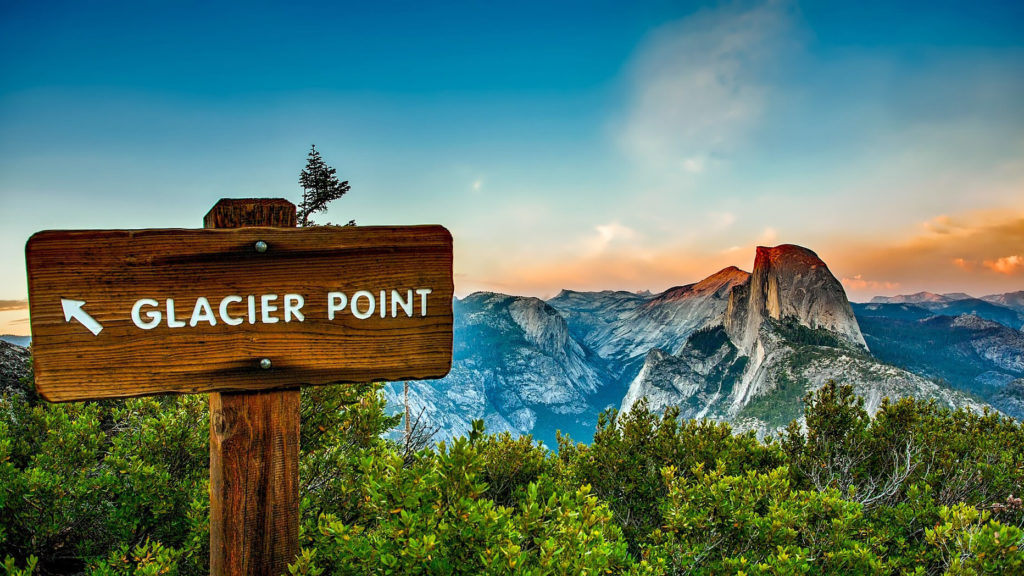
Glacier Point is a scenic overlook located in Yosemite National Park in California, USA. It is situated on a high point overlooking Yosemite Valley, and offers stunning views of Half Dome, Yosemite Falls, and other landmarks.
Glacier Point can be accessed by car or shuttle bus from Yosemite Valley, or by hiking one of several trails that lead to the overlook. The most popular hiking trail to Glacier Point is the 4-mile (6.4 km) Four Mile Trail, which begins at Yosemite Valley and ascends over 3,200 feet (975 meters) to the overlook. The trail is considered strenuous, but the views from the top make it well worth the effort.
At Glacier Point, visitors can take in panoramic views of Yosemite Valley, including El Capitan, Half Dome, and Yosemite Falls. There is a large parking lot at the overlook, as well as restrooms, a snack stand, and a visitor center that provides information about the geology and history of the area.
Glacier Point is especially popular at sunset, when the light can create dramatic shadows and illuminate the valley in shades of pink, orange, and gold. Visitors are advised to dress warmly and bring a jacket, as temperatures at the overlook can be cooler than in the valley.
8. Bridalveil Fall
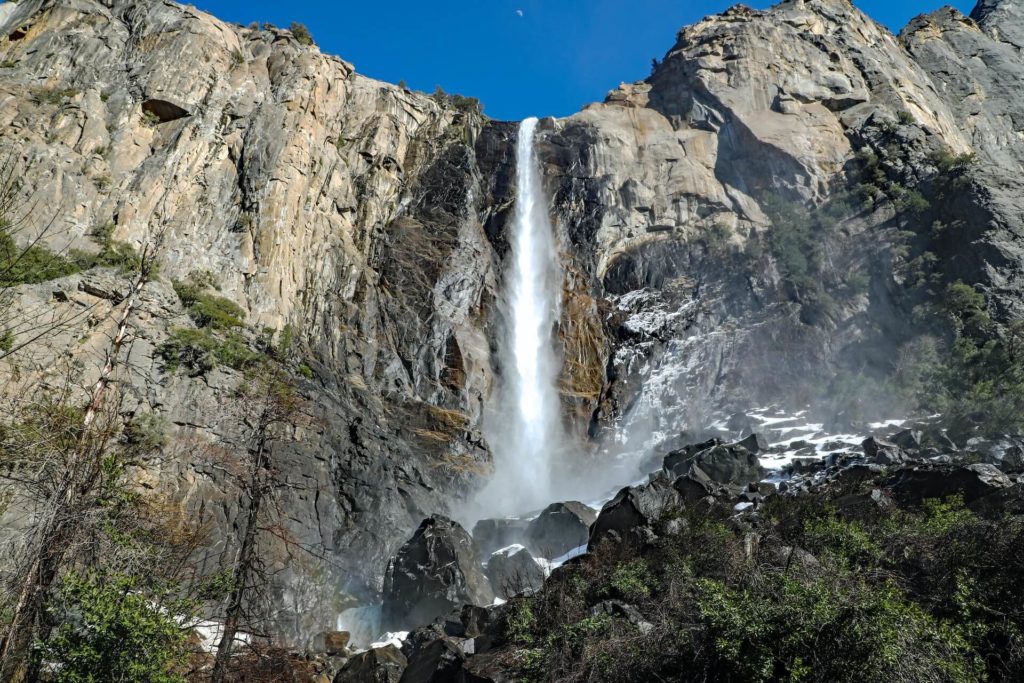
Bridalveil Fall is a waterfall located in Yosemite National Park in California, USA. It is one of the most popular waterfalls in the park, and can be viewed from several locations within Yosemite Valley.
Bridalveil Fall drops approximately 620 feet (189 meters) from a granite cliff, and is fed by snowmelt and seasonal rainfall. The waterfall is named for its delicate, veil-like appearance, which is created by the mist and spray that surrounds the falling water.
Visitors to Bridalveil Fall can view the waterfall from several locations, including a parking area near the base of the fall and a short, paved trail that leads to a viewing platform. The trail is relatively easy and suitable for visitors of all ages and abilities.
Bridalveil Fall is especially beautiful in the spring, when the flow is at its highest and the mist and spray create rainbows in the sunlight. Visitors are advised to bring a rain jacket or poncho, as the mist from the waterfall can be quite heavy and can soak visitors who are standing near the base of the fall.
9. Tioga Road

Tioga Road is a scenic drive that runs through Yosemite National Park in California, USA. The road is approximately 46 miles (74 km) long, and connects Yosemite Valley to the eastern side of the Sierra Nevada mountain range.
Tioga Road is only open to vehicles from late spring to early fall, usually from late May or early June to October, depending on weather and snow conditions. The road offers stunning views of the park’s high country, including Tuolumne Meadows, Tenaya Lake, and the surrounding granite peaks.
Along the way, there are several pullouts and vista points that offer scenic views and photo opportunities. Some popular stops along Tioga Road include Olmsted Point, which offers a panoramic view of the surrounding peaks and valleys, and Tuolumne Meadows, a beautiful alpine meadow surrounded by granite peaks.
Tioga Road also provides access to several hiking trails, including the popular trail to the top of Clouds Rest, which offers stunning views of the surrounding mountains and valleys.
Visitors driving on Tioga Road are advised to check road conditions and weather forecasts before embarking on the drive, as the road can be closed or restricted due to snow or other weather conditions. Drivers should also be prepared for steep grades, winding roads, and narrow sections of the road, and should drive slowly and cautiously.
10. Yosemite Museum and Indian Village
The Yosemite Museum and Indian Village is a cultural center located in Yosemite National Park in California, USA. It is dedicated to preserving and sharing the history and culture of the park’s indigenous people, including the Southern Sierra Miwok and the Ahwahneechee people.
The museum features exhibits on the history of the park’s indigenous people, including their traditional lifeways, art, and cultural practices. The exhibits include artifacts such as baskets, clothing, and tools, as well as photographs and other historical documents.
The Indian Village is a replica of a traditional Miwok village, and features reconstructed dwellings and interpretive exhibits that provide insight into the daily lives and culture of the park’s indigenous people. Visitors to the Indian Village can participate in guided tours and demonstrations, such as traditional basket weaving, acorn processing, and fire making.
The Yosemite Museum and Indian Village is located near the Yosemite Valley Visitor Center and is open year-round. Admission is included with the park entrance fee. The museum also offers educational programs and workshops for visitors of all ages, as well as outreach programs for schools and other organizations.
11. Ansel Adams Gallery
The Ansel Adams Gallery is a photography gallery and store located in Yosemite National Park in California, USA. The gallery is named after the famous landscape photographer Ansel Adams, who was known for his iconic black and white photographs of Yosemite and other natural landscapes.
The Ansel Adams Gallery features a collection of photographs by Adams and other artists, as well as books, postcards, and other items related to photography and the park. The gallery also offers photography workshops and classes for visitors who want to learn more about photography and improve their skills.
In addition to the gallery, the Ansel Adams Gallery also operates several other businesses within Yosemite National Park, including a bookstore, a cafe, and a framing shop. The gallery and its affiliated businesses are owned and operated by the family of Ansel Adams, and are committed to preserving and sharing the legacy of Adams and his work.
The Ansel Adams Gallery is located in Yosemite Village, near the park’s main visitor center, and is open year-round. Admission is free, and visitors are encouraged to take their time and enjoy the beautiful photographs and artwork on display.
12. Camping
Yosemite National Park offers several campgrounds for visitors who wish to stay overnight in the park. Camping in Yosemite is a popular way to experience the park’s natural beauty and enjoy outdoor recreation.
Some popular campgrounds in Yosemite include:
- Upper Pines Campground: Located in Yosemite Valley, Upper Pines is the largest campground in the park, with 238 sites. It is open year-round and offers access to hiking trails, rock climbing, and other outdoor activities.
- Lower Pines Campground: Also located in Yosemite Valley, Lower Pines is smaller than Upper Pines, with 60 sites. It is open from spring to fall and offers easy access to hiking trails, waterfalls, and other attractions in the valley.
- Tuolumne Meadows Campground: Located in the park’s high country, Tuolumne Meadows is a beautiful alpine meadow surrounded by granite peaks. The campground has 304 sites and is open from summer to fall, offering access to hiking trails, fishing, and other outdoor activities.
- Wawona Campground: Located near the southern entrance to the park, Wawona is a popular campground with 93 sites. It is open year-round and offers access to hiking trails, the Mariposa Grove of Giant Sequoias, and other nearby attractions.
Reservations are strongly recommended for camping in Yosemite, especially during the peak season (summer). Some campgrounds also offer first-come, first-served sites, but these can fill up quickly, so it is advisable to arrive early in the day. Campers should also be prepared for changing weather conditions, and should follow park rules and regulations to help protect the park’s natural resources.
13. Biking
Yosemite National Park offers several opportunities for biking, including scenic roads and trails that allow visitors to explore the park’s natural beauty on two wheels.
Biking is permitted on most roads within Yosemite, including the 12-mile (19 km) loop road in Yosemite Valley, which offers views of Half Dome, El Capitan, and other landmarks. Biking is also permitted on some unpaved roads, including the Old Tioga Road, which runs parallel to Tioga Road and provides access to scenic vistas and hiking trails.
In addition to road biking, Yosemite also offers several mountain biking trails, including the Valley Loop Trail, which is a 13-mile (21 km) paved trail that circles Yosemite Valley, and the Hetch Hetchy Road, which is a 7-mile (11 km) unpaved road that offers views of Hetch Hetchy Reservoir and the surrounding mountains.
Bikers in Yosemite are advised to follow park rules and regulations, and to be aware of potential hazards such as wildlife, steep grades, and changing weather conditions. Bikers should also be prepared with appropriate safety gear, such as helmets and lights, and should carry plenty of water and food. Some areas of the park may have restrictions on biking, so visitors are advised to check with park rangers or visit the park’s website for up-to-date information on biking opportunities in Yosemite.





